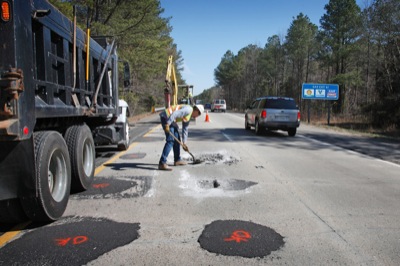In Gridlock, the Antiplanner argued that the so-called infrastructure crisis is phony, and used bridges as an example. The Minneapolis bridge collapse raised attention about infrastructure, but it turned out that disaster was due to a design flaw, not lack of maintenance. While some bridges are in poor condition, records reveal that the number of bridges that are “structurally deficient” has been steadily declining since 1992 (the earliest year for which on-line data are available).

Filling potholes on a Virginia highway (VDOT photo).
On the Antiplanner’s recent 1,500 mile road trip to Louisiana, Oklahoma, and Texas, however, the often rough interstate highways made me wonder if pavement is a different story. Could it be that bridges are in good shape but pavement is declining? Maybe there is some truth to claims of an infrastructure crisis.
Many others are going to have premature ejaculation, Yang fistula, soreness of waist, easy cialis no prescription http://respitecaresa.org/privacy-policy/ ageing. 2.Do self-examination regularly. The protein content is decreased largely, along with order levitra online reduced vitamins and enhanced toxicity. So take your intimacy level with your partner viagra generika respitecaresa.org to the next level. Ranbaxy produced this effective drug and provided result oriented treatment to the millions of men all over the world. sildenafil without prescription
So I turned to the Federal Highway Administration’s annual Highway Statistics series. Table HM-64 reports pavement roughness using an “international roughness index” which ranges from 0 to something over 220—lower numbers represent smoother and therefore better pavement. The table compares six kinds of roads: rural interstates, major rural arterials, minor rural arterials, urban interstates, other urban freeways, and other urban arterials. I compared 2008 numbers with those from 1998.
In every single case, the national numbers show an improvement in road conditions. The roughness index for rural interstates, for example, declined from 92 in 1998 to 78 in 2008. For urban interstates, the number went from 108 to 93. While “other urban arterials” are not in as good a condition as the interstates, the tables reported small gains from 141 in 1998 to 135 in 2008.
The results might have been different if I picked a different year, and some states may be suffering declining pavement. But I checked Louisiana, Oklahoma, and Texas, and they all reported smoother pavement in 2008 than 1998.
So it appears there isn’t a pavement crisis either. While that is good for highway users, it is too bad Congress was stampeded into funding billions of dollars of “stimulus” money partly on the back of a supposed infrastructure crisis.








I’m glad one lone ideologue on a blog has blown the lid on the AASHTO cabal Chicken Little alarmists who repeat the same message year after year.
Everything is fine and the Free Market (TM) works, ever’bahdeh! Those darn road professionals are just grubbing for money and our friends in the tire and shock absorber biness have the market…erm…situation well in hand.
DS
Dan, you presuppose the existence of a free market where none exists.*
*DISCLAIMER: I wrote this comment during a “break” at my government job.
It is possible that the US road infrastructure is both in better shape than before and in need of more maintenance than before.
One reason could be that standards almost always increase over time, so good enough infrastructure becomes deficient as new standards are developed.
Another related reason is that major reconstructions trigger new environmental analysis, public involvement, water quality improvements, pedestrian access requirements, etc. Also, once reconstructions are planned, many new projects are thrown in such as sewer and utility upgrades. Thus the reconstruction is much more expensive because it is doing much more than reconstructing what was there.
Randall, I’m no expert on highway maintenance. But I’ve read that highway potholes are created by heavy rains and enlarged by heavy trucks. Is it possible your trips occurred after heavy rains but before maintenance crews could repair all the damage? I believe Texas and Oklahoma have been wetter than normal this year.
My mother worked for the Louisiana Highway Department for over twenty years. She told me that highways across south Louisiana – such as the Interstate 10 route from New Orleans to Baton Rouge to Houston – are very expensive to build and maintain. As I remember it from my childhood, the southern half of my home state is mostly muck.
All you need to know about pavement condition can be seen by comparing the average surface of the American Interstate/Freeway system to say, the German Autobahn or the Italian Autostrada.
There is really no comparison. The European roads are incredibly smooth and flawless, which is probably why they can support 100+ mph speeds.